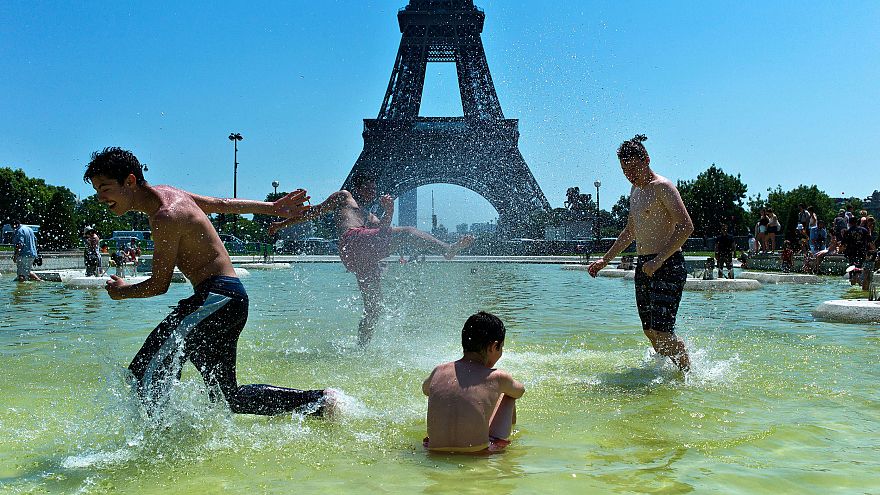Europe in Roast Mode
"What we're seeing today is making me, frankly, calibrate not only what my children will be living, but what I will be living, what I am currently living."
"We haven't caught up to it. I haven't caught up to it, personally."
Kim Cobb, professor of earth and atmospheric science, Georgia Institute of Technology, Atlanta
"Decades ago when the science on the climate issue was first accumulating, the impacts could be seen as an issue for others, future generations or perhaps communities already struggling."
"In our increasingly muggy and smoky discomfort, it's now rote science to pinpoint how heat-trapping gases have cranked up the risks"
"It's a shift we all are living, together."
Katherine Mach, climate scientist, Stanford University
/https%3A%2F%2Fblueprint-api-production.s3.amazonaws.com%2Fuploads%2Fcard%2Fimage%2F818289%2F93557152-de06-4177-ad81-32e7f328cb67.png) |
|
Image: windy.com
|
According to a study published in the journal PLOS Medicine last month, a five-fold rise for the United States is predicted in mortality rates, resulting from exposure to extreme heat events by the year 2080. The prognosis, understandably, for other, less wealthy countries is considerably worse; as example, for the Philippines, researchers forecast twelve times a greater number of death events to result from extreme heat occurrences as time progresses.
As for the year of 2018, it is looking like it will be known as the fourth-hottest year on record, lagging the three years previous, a string of records unenviably representing a portion of an accelerating rise in temperatures -- beginning at the introduction of the industrial age. And representing, according to the scientists studying it, clear evidence of greenhouse gas emission-caused climate change.
Regardless of whether variations in weather patterns result in coming years in the introduction of some cooler years interspersing the warming trend, the result is obvious; 17 of the 18 warmest years reflecting modern record-keeping have taken place since 2001. "It's not a wake-up call anymore. It's now absolutely happening to millions of people around the world", stated Cynthia Rosenzweig, operating the climate impacts group at the NASA Goddard Institute for Space Studies.
It now appears inevitable that with rising temperatures heat waves are certain to become increasingly intense, and more frequent occurrences can be anticipated as emissions continue to rise. Should events continue on the same plane, a future of cascading system failures that will certainly threaten basic necessities from food supply to electricity are on the horizon. The imminence of these threats is just now penetrating he consciousness of some scientists with the realization that climate change is directly impacting their lives right now.
Thus far on an international scale, 2016 has the distinction of being recognized as the hottest year on record which squared with the concomitant event of an El Nino, the climate cycle out of the Pacific whose effect is to amplify atmospheric heat. And then there was 2017, absent an El Nino event but nonetheless almost as hot as the year before. According to the National Oceanic and Atmospheric Administration, 2017 rates as either the second or third-warmest year on record. Which makes 2018 the fourth warmest.
Sea levels are rising about three inches higher than levels seen in1993. "We are living in a world that is not just warmer than it used to be. We haven't reached a new normal. This isn't a plateau", warned Daniel Swain, a climate scientist at the University of California Los Angeles, who points out these latest statistics vindicate the mathematical models reflecting the scientific community's findings.
After holding steady for the previous three years, industrial emissions of carbon dioxide grew to record levels in 2017; atmospheric carbon was found to be at the highest levels in 800,000 years. Many of the world's greatest polluters inclusive of the United States -- the only country that pulled out of the Paris accord on global warming -- are simply not following through on their pledge of reduction targets, voluntary though they are. Despite which, scientists still hold out hope that changes in how we live can help reduce greenhouse gas.
Melbourne, Australia is planting more trees, and Ahmedabad in India is planning to cover rooftops with reflective white paint; modest measures to be sure, but the hope is that if enough places make an effort it will reflect globally. Agronomists are focusing on the development of seeds that may survive heat and drought. Switzerland is focusing in painting railway tracks white to prevent them from buckling in adverse heat conditions.
The downside is the impact of heat and drought on farms, where in El Salvador, farmers are faced with a failed corn harvest in the country's east as heat soared to 41C and no rain fell for 40 days. Many EU countries are seeing their wheat production decline this year; Britain seeing a five-year low, and German farmers predicting lower grain harvests than normal, while Sweden's record-high temperatures have produced parched fields and desperate searches to find livestock odder.
"We get quite a few phone calls from farmers who are lying awake at night and worrying about the situation. This is an extreme situation that we haven't seen before", noted Palle Borgetrom, president of the Federation of Swedish Farmers -- estimating a $1-billion agriculture sector loss.
 |
Labels: Agriculture, Climate Change, Europe, Heat, Weather

<< Home